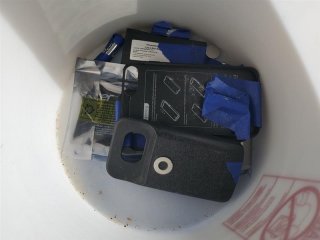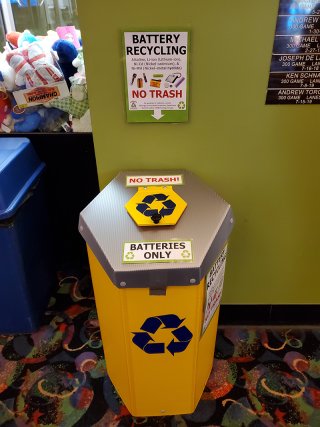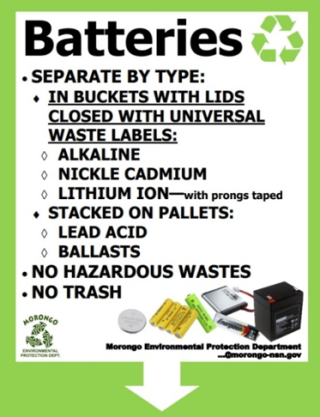Battery Collection in Action Case Study: The Morongo Band’s Battery Program
On this page:
Introduction

Located near Banning, California, between Los Angeles and Palm Springs, the Morongo Band of Mission Indians operates a battery collection program for Tribal members and businesses. The Morongo Band consists of about 1,300 Tribal members, with 900 living on the reservation and 400 off reservation.
The Tribe provides battery collection services to:
- Reservation residents.
- Members.
- Non-member businesses renting space on the reservation.
- Tribal-run organizations.
- Businesses including a casino, restaurants, a golf course, two gas stations, and a bowling alley.
- Tribal government buildings.
The program began in response to Resource Conservation and Recovery Act regulations and concerns about environmental impact and evolved to collect and recycle batteries to further reduce environmental impacts and improve safety.
Morongo’s battery collection program aims to offer easy access to alkaline, lithium-ion, nickel-cadmium, nickel metal hydride, and lead-acid battery collection. Funded by the federal Indian Environmental General Assistance Program, the program reaches Tribal members through targeted outreach and community events organized by the Tribal government’s Environmental Protection Department Pollution Prevention Program. The Tribe stores collected batteries according to the Resource Conservation and Recovery Act and contracts with battery recycling or hazardous waste disposal companies for transport.
Program Design and Implementation
The Morongo Band of Mission Indians has collected hazardous waste, electronic waste, and batteries (pdf)(1.1 MB) for over 30 years. The Tribal government’s Pollution Prevention Program, consisting of one full-time and one part-time employee, oversees programming and reporting. The program maintains several unstaffed collection sites across the reservation, including a public drop-off site near the public works department, a site in the bowling alley, and collection bins at Tribal government buildings.
Collection Sites
Public drop-off site: This site accepts batteries and other waste in separate, labeled bins near the public works department. Due to being unstaffed and having multiple waste streams nearby, it experiences higher rates of contamination and improper battery disposal.
Bowling alley collection site: Located in the bowling alley, this site exclusively collects batteries. The Tribe chose this location to provide Tribal Elders with better access to proper battery disposal. People use this site frequently and provide the Tribe with positive feedback on it.
Collection bins in Tribal government buildings. Each department in Tribal government buildings has bins for collecting batteries and electronic waste. These bins have clear labels, and employees receive training on their proper use.
Education and Outreach

Morongo uses Tribal education and outreach campaigns to promote awareness of collection site locations and their proper use. They employ clear signage, social media platforms such as Instagram, email newsletters, booths at Tribal events, lessons in elementary schools, and annual collection events to spread information about the battery collection program. Their educational content includes motivational messaging on the environmental benefits and financial incentives of battery recycling, as well as explanations of how proper lithium-ion battery sorting and collection reduces community risk by preventing truck fires. A recent fire in the local area caused by improper battery disposal serves as a pertinent example, and fires remain a significant concern.
Audience Alignment
Morongo’s outreach strategies target various audiences. Instagram engages a younger demographic with frequent updates, while email newsletters reach older community members. Tribal waste management staff teach fifth graders about the importance of proper battery collection and recycling. This strategy is effective, as parents of students often attend Tribal collection events to dispose of batteries in school-distributed containers.
Outreach Events
The Tribe holds annual battery waste collection events to support electronic waste and hazardous waste collection. These events encourage Tribal members to bring waste for proper sorting and management. Since 2011, the Tribe has increased its annual residential battery collection by over 300 percent.
Supporting Tribal Businesses

Tribal General Assistance Program funding does not directly apply to businesses, so Tribal businesses must fund their own collection programs. Tribal government employees provide advice rather than directly operating or funding these sites. Instead, the Tribe supports battery and electronic waste collection for Tribal-run businesses through training, labeling, and signage. The Tribal Pollution Prevention Program trains employees to collect, sort, and handle batteries, and conducts an annual audit to ensure compliance with disposal rules.
Frequent employee turnover and varying interest levels in proper battery disposal pose challenges for Tribal businesses in maintaining consistent collection and disposal systems. To ensure consistency, the Tribal Pollution Prevention Program provides clear labeling, standard operating procedures, and instructions with simple images to assist employees who speak languages other than English.
What Works Well
Education and outreach are crucial to the battery collection program. Morongo communicates with its members clearly and simply through targeted channels, helping them to use collection sites effectively and understand the importance of battery recycling.
In response to Tribal Elders’ requests for more accessible battery collection, the Tribe added a collection site at the frequently visited bowling alley. This kiosk fills up quickly compared to other sites.
The battery collection program partially funds itself through rebates from battery recycling companies, which pay the Tribe based on the scrap value of batteries. One company provides rebates for lead-acid batteries, while another offers rebates for other chemistries, including alkaline, lithium-ion, and nickel cadmium.
Challenges Encountered
The program requires more staff than the Tribal government can currently provide. Contamination challenges occur at the public drop-off site near the public works department, where the Tribe collects batteries, household recycling, landfill waste, and other waste types in the same area. A lack of staff monitoring leads to higher contamination rates.
Maintaining battery and electronic waste collection from Tribal-owned businesses is challenging due to high staff turnover, making consistent education, training, and procedures difficult to uphold. Limited funding for the Tribal Pollution Prevention Program prevents staffing increases and larger battery projects from taking place.
Evaluation Metrics
To receive General Assistance Program funding, the Morongo Band of Mission Indians must collect monthly data on their battery recycling program. Battery and hazardous waste haulers provide the Tribe with the weight of batteries they haul and recycle. From 2011 to 2024, battery collection across residential, business, and Tribal government sites increased by 367 percent, from 600 pounds to 2,800 pounds. The Tribe also uses simpler, site-specific metrics, such as how quickly a collection site fills up and the contamination rate at each site. High usage and low contamination rates indicate success, though Morongo may not include these rates in official reports. The Tribe monitors these metrics through audits and uses the information to refine education and outreach efforts.
Key Takeaways and Lessons Learned
- Education and outreach should use the type of media most used by the demographic the program is trying to reach.
- Set up collection sites in a variety of locations to meet the needs of the community.
- Collection events for various items, including batteries, can promote proper disposal, education, and community engagement.
- Clear signage and bins designed for specific waste types are crucial to reduce contamination, but staffing at drop-off locations can further minimize contamination through direct education and monitoring.
- Partnerships with battery recyclers that offer rebates contribute to the financial sustainability of a collection program.
- Battery collection at businesses is challenging due to high turnover and low employee buy-in. Consistent staffing and top-down administration could improve consistency, but there is currently no funding for additional staff.
Insights and Next Steps
The Morongo Band of Mission Indians aims to further increase battery collection and recycling rates on their reservation and within Tribal businesses. They plan to continue listening to feedback and offering targeted solutions through adaptable education and outreach strategies, addressing contamination challenges at the public drop-off site and other locations. Rapid staff turnover remains an issue at Tribal businesses, but Morongo expects the appointment of a new director of the Environmental Protection Department to help tackle these challenges and facilitate program growth.
